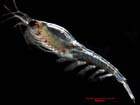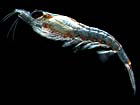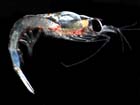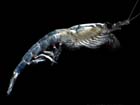Krill: Euphausiids
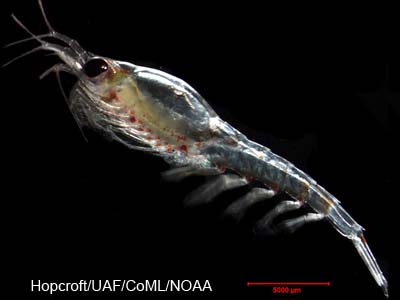
Euphausiids are commonly called krill. After the copepods, euphausiids often rank second or third in terms of abundance in most oceanic waters, but are not common in the arctic’s central basins. As adults they range in size from 1-15 cm in body length, almost classifying as nekton (“swimmers” like fish) rather than plankton (“drifters”). Many of the species within this group undergo pronounced daily migrations spending the day at several hundred meters depth and coming to the surface to feed each night. They often form dense swarms that make them very patchy in terms of their overall distribution. They are a major food item for many other larger planktonic species, fish, sea-birds, seals, and the baleen whales. They are famous enough to have secured a cameo appearance in Disney’s “Finding Nemo”.
Overall they are shrimp-like in appearance, with well developed eyes and antennae, but are easily distinguished form the true shrimp by the presence of external gills below the main body (thorax). They are generally filter-feeders eating phytoplankton, detritus and small zooplankton using the legs on their thorax to sieve the surrounding water. Some species are distinctly predatory. All species swim by using the 5 pairs of legs on their abdomen, and for rapid movement they will also use the “flukes” on their tail for forward or backward escape.
Like insects and copepods, they grow by casting off their old exoskeletons, going through 3 different types of larval stages (nauplius, calyptopis, furcilia; usually 13 stages in total) after hatching before becoming juveniles. The juveniles and adults have an unfixed number of stages. The adults of all arctic species scatter their eggs in the water column. Eggs are typically 0.3 mm in diameter.
They can be found all the way from the surface to the bottom of the oceans, although most species have a specific range of depth over which they are found. We know little for sure about how long most species live in the Arctic, but it is likely on the order of 3-5 years.
Nine (9) species of euphausiids are known to exist in the arctic, however several of them are extremely rare (Euphausia pacifica, Thysanoessa spinifera) or uncommon (Nematoscelis megalops, Stylocheiron maximum) in the Arcitc proper.
Page Author: Russ Hopcroft
Updated: Sept 4, 2010


